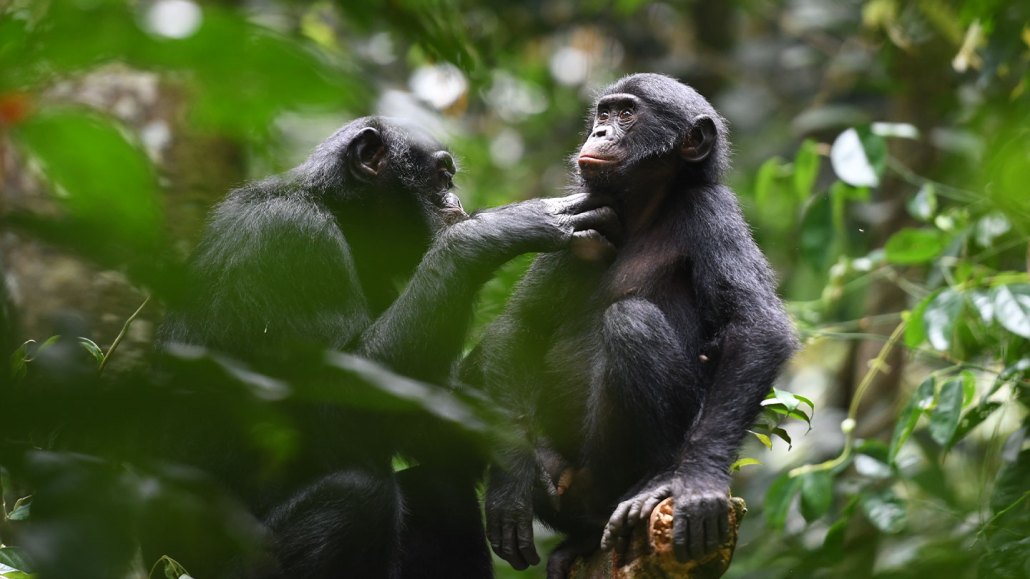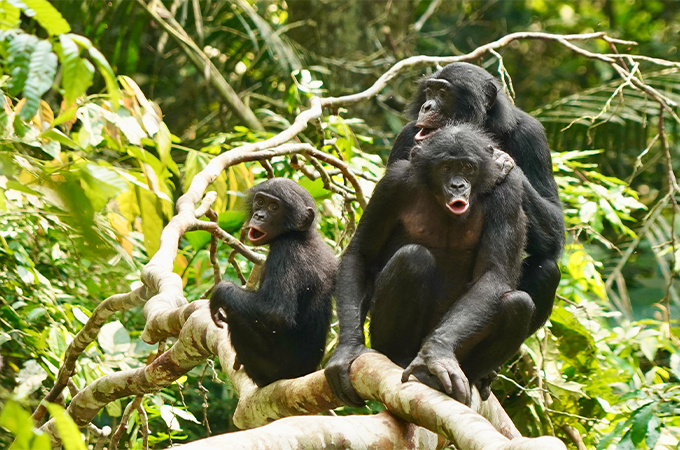
An adult female in the Congo’s Kokolopori Bonobo Reserve grooms an adolescent male from a neighboring group of unrelated bonobos.
M. Surbeck/Kokolopori Bonobo Research Project
By Jake Buehler
- More than 2 years ago
Read another version of this article at Science News Explores
Humans regularly cooperate and share resources with other, unrelated humans in different social groups, often without any immediate, reciprocated benefits. The phenomenon has been considered unique to our species. But some bonobos appear to share this social trait, a study finds.
This type of cooperation is thought to underpin human civilization. So bonobos’ ability to bond and cooperate with groups of nonrelatives across group boundaries, even when there’s no immediate payoff, may provide some insight into the kinds of evolutionary conditions that led to the development of humankind’s large-scale societies, researchers report November 16 in Science.
Both chimpanzees (Pan troglodytes) and bonobos (P. paniscus) live in social groups with individuals that may not be very closely related. But compared with territorial and aggressive chimpanzees, bonobos have a more easygoing, tolerant attitude toward other groups. Bonobos occasionally groom and share food with unrelated individuals from other social groups and have even been known to adopt outsiders’ young (SN: 3/18/21). But the extent of the apes’ cooperative behavior has been unclear.
So behavioral ecologists Liran Samuni of the German Primate Center in Göttingen and Martin Surbeck of Harvard University studied two bonobo groups in the Congo’s Kokolopori Bonobo Reserve. Over two years, the team recorded which bonobos exchanged grooming services and shared food, and when.
Conflict and competition are not completely absent among bonobos. So the researchers also recorded when the apes formed alliances with members of the other group, cooperating to attack a third individual.
The two groups encountered each other frequently. They interacted with each other nearly 100 times over the study, sharing 20 percent of the two-year observation period in each other’s company. Some meetings lasted for just an hour, others for multiple weeks, allowing for longer-term bonds to be forged.
While the bonobos were together, the researchers documented many instances of cooperative behavior. Of the more than 3,700 grooming interactions observed, 10 percent were between bonobos of different social groups. Of all partnerships formed to attack a third individual, 15 percent were between bonobos of different groups.
“This is not a one-off kind of thing,” Samuni says, where individuals share food very occasionally, for example. In the Kokolopori bonobos, 6 percent of all food shares were across groups.
The cooperation wasn’t random. Individuals that tended to engage in cooperative behavior within their group were more likely to interact with bonobos in the other group that had the same tendency. This cooperation doesn’t appear to be solely motivated by immediate reciprocation, the researchers say. For instance, during the study, only 14 percent of bonobos that shared food with a partner in the other group had the deed reciprocated.
The study’s overall findings build on evidence from bonobos in captivity behaving similarly and raises the possibility that cooperating with nonrelatives across social groups is intrinsic to the species. Many animals will aid and cooperate with relatives, since such behavior encourages the survival and proliferation of one’s own genes, albeit indirectly. When helping nonrelatives, the evolutionary benefit is even more indirect, and doesn’t evolve as readily.

Bonobos aren’t the only nonhuman animals known to behave in this way. Male dolphins will cooperate with other unrelated males to guard females, which increases their own chances of mating. But, unlike with a lot of the bonobo cooperation observed in the new study, there’s a clear, self-directed benefit involved in the dolphins’ behavior.
Food sharing between unrelated individuals, though, is rare, Samuni says. Vampire bats, bonobos and humans are among the few species known to do it. Chimps also do this, but share food only within the social group, Surbeck says. In human evolution, such sharing “is considered one of those behaviors that supported our societies, that allowed us to sustain each other in terms of food shortfalls,” Samuni says.
Our own species’s behavior is what makes the new result particularly interesting, says Shinya Yamamoto, a comparative cognitive psychologist at Kyoto University in Japan.
“Humans sometimes compete or fight with neighboring groups, but other times we cooperate even with outgroup members,” Yamamoto says. Among our primate relatives, it’s been easier to find examples of aggression and competitiveness, especially in humans’ close relatives, chimpanzees. But the evolutionary origins of humankind’s cooperative side remain unclear.
Humans are equally related to chimpanzees and bonobos, and the new research doesn’t tell us whether early human ancestors were more like chimps with their universally rigid territories and lethal patrol groups, or like the more relaxed bonobos (SN: 9/17/14). But the finding could lead to insights into the types of conditions in which either side of the coin evolves, Surbeck says.
“Under which circumstances do you see this cooperation? Under which circumstances do you see more of a chimpanzee pattern, in permanently hostile relationships between groups?” he asks. “What shifts the needle from one to the other?”
The finding also suggests that extensive, long-term cooperation between groups can occur without the heavy influence of cultural factors and social norms. In humans, these have been considered necessary to build and sustain between-group cooperation, Samuni says.
“We are showing quite a simple system,” she says. “And we still see it emerging and in a way that is quite similar [to humans].”
There could still be a cultural component at play with these two bonobo groups, Yamamoto says. It’s possible that over generations, some bonobos have learned to be particularly social, similarly to how elements of human culture form.
This study looked at just two wild bonobo groups, and other bonobo groups are known to have variable rates of interaction with other groups, Yamamoto says. So studying more of the apes might reveal something akin to social norms.






